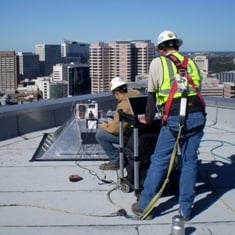The Impact of Building Envelope Commissioning
By: Bill Coltzer, Jr., AIA President, Zero/Six Consulting, LLC
If you’ve participated in the construction of high performance buildings, you’re probably familiar with the term commissioning, although the term has an ever growing range of meanings. In short, commissioning verifies building systems actually perform as they are designed and engineered. Historically, commissioning has focused on mechanical, electrical and IT systems; however, it’s becoming more common to also include the exterior building envelope particularly in the healthcare and research arenas. Unfortunately, no one really knows how to scope the work for the envelope portion of the commissioning process. The envelope is often added as a single line item to a lengthy commissioning specification. One can imagine the variety of responses “commission the exterior envelope” garners from proposers. As an industry, we have the opportunity to influence the development of envelope commissioning protocol.
Multiple reasons exist for the increased popularity of envelope commissioning, but two factors stand out above all others. First is the vast amount of litigation related to water infiltration. This immense market is comprised largely of new buildings less than five years old. In fact, projects that have yet to achieve final completion and are suffering moisture infiltration comprise a large portion of the work at Zero/Six. Second, the demands on mechanical systems for efficiency and air quality control continue to rise. The building envelope is the ultimate building plenum (duct). The ability of sub systems within the envelope to perform is closely related to the tightness of the building envelope.
Develop the Intent
Commissioning is as much a design verification process as a quality assurance process. In traditional MEP/IT commissioning, the commissioning agent is placed on the project team very early to provide input during design. This is to ensure that if a facility is constructed as shown in the construction documents, it will perform as specified. It is equally important that the envelope commissioning begins early along with MEP/IT. Think about it. If a pump, switch or air handler does not perform, it can be replaced; however, if a flashing is left out, portions of the cladding may have to be removed to install it. Then consider the same flashing might have been left out at every window of an occupied high rise structure and now you have a remedial project that will require significant time and funding. One of the goals of envelope commissioning in the design phase is to address details before they become issues.
Because building architecture varies from project to project, mock ups of the project specific conditions are invaluable. Although cladding systems may be repeated among various projects, the relationship to adjacent systems is always changing. In these interfaces lie unlimited new scenarios needing to be fully considered and addressed. With the evolution of Building Information Modeling (BIM), many of these mock ups can be generated inexpensively on a virtual platform, although for testing purposes, there is no substitute for a full size working mock up.
Inspect the Product
Once construction documents convey intent, the next step is a quality control (QC) program executed by persons who understand how the various systems will interface. The success of the QC program is largely dependent on the ability of the inspector to safely access hard to reach areas regularly. As part of the QC program, deficient work is logged as it is observed and tracked to resolution. In other words, no punch list surprises at the substantial completion date.
Test the Collaborative Effort
Because testing verifies design as well as construction, it should be done as early in the process as practical so repetitive deficiencies can be corrected prior to a full blown remediation effort. In other words, if a window is being improperly installed, catch it with testing at 10 percent completion, not 100 percent. Testing commonly included in envelope commissioning includes:
- Flood testing of below-grade areas and waterproofed terraces
- Pull testing of sealant joints
- Water infiltration testing of windows per ASTM E1105
- Roof Uplift Testing per ASTM E907
- Thermal imaging envelopecomponents
Count the Cost
While commissioning the exterior building envelope is an additional line item in the project estimate, it rarely adds to the bottom line of the total project cost. More often, it safeguards project budgets and deadlines. Projects that do not address envelope issues up front often end up addressing them near substantial completion due to failed testing. The cost associated with recovery programs are almost always more than the cost associated with an envelope commissioning program, sometimes substantially more. Unfortunately, the following case study is not unique:
A high rise project had over 1600 high performance, prefabricated punched windows in pre-cast concrete openings. In an effort to provide better quality control of the window units, the contractor elected to fabricate these units off site in a shop environment. The project team included a premier architect, a first class construction team, a first class product and the world’s easiest window installation detail. No problem, right? Wrong! Somewhere between the shop and the project site, the units were ever so slightly damaged  resulting in water infiltration during rain events. We suspect the damage was related to shipping and crating due to the consistent nature of the defect, but it really does not matter. (Mind you, the units were laboratory tested in the city where manufactured.) A commissioning program would have tested these installed windows early and established a recovery plan which would have prevented the post mortem removal of 1600 windows delaying occupancy for three months. The process of testing would have been pennies compared to the removal of installed windows.
resulting in water infiltration during rain events. We suspect the damage was related to shipping and crating due to the consistent nature of the defect, but it really does not matter. (Mind you, the units were laboratory tested in the city where manufactured.) A commissioning program would have tested these installed windows early and established a recovery plan which would have prevented the post mortem removal of 1600 windows delaying occupancy for three months. The process of testing would have been pennies compared to the removal of installed windows.
In closing, the whole building commissioning process including the envelope -- is an invaluable tool for the entire project team. Potential performance issues can be identified and addressed during design thus defusing construction defect claims where mediation finds everyone writing checks. Additionally, commissioning provides well documented building performance at building delivery preventing maintenance issues from becoming design or construction claims. Commissioning is a vehicle that allows you to simultaneously protect your firm while increasing client satisfaction.
Develop the Intent + Inspect the Product + Test the Collaborative Effort
With a background in both construction and architecture, Bill formed Zero/Six Consulting in 2003 with the goal of improving technical quality from all disciplines regarding exterior envelope. The firm provides peer reviews, forensic investigations, quality control inspections and expert testimony. In 2010, the firm’s existing testing department formed Z6 Commissioning, LLC – a certified HUB entity. Bill can be reached at 409-740-0090 or info@z6consulting.com.
Subscribe Today!
Stay-in-the-know and subscribe to our blog today!
